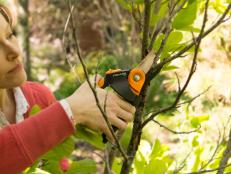Pruning a Hedge
No matter what type of hedge you may have in your landscape, follow these steps to keep it healthy and shaped beautifully.

Shutterstock/Pixavril
Materials Needed
- hedge shears, manual or electric
- hand pruners
- tarp
- lawn rake
Step 1: Determine Your Hedge's Habit
When you cut the end off a branch, dormant buds below the pruning cut sprout into new twigs. But not all shrubs have dormant buds, and those shrubs won't grow new twigs if pruned too severely. For that reason, it's best to prune evergreens only into the soft, current year's new growth. Many deciduous shrubs (those that shed their leaves in autumn) can tolerate pruning into old wood from previous growing seasons.
Step 2: Assemble Your Tools
Use manual hedge shears for small hedges and electric shears for large jobs. If your shears do not have a pruning notch near the base of the blade, you may need hand pruners to cut twigs larger than 1/4 inch in diameter. Use a tarp to collect trimmings or a rake to clean up afterward.
Step 3: Prune at Planting Time
When you plant a new hedge, prune vigorous shrubs, such as privet, by reducing the length of the branches and shrub height by one-fourth to one-third. Do not prune the tops of slower and denser-growing evergreens and conifers, such as arborvitae, until they reach their desirable height.
Step 4: Establish Shape
All branches need adequate sunlight for strong growth. As the hedge grows, prune the sides so the bottom is slightly wider than the top to prevent the upper limbs from shading the lower ones. In snowy climates, give hedges rounded or sloped tops to help them shed snow easily.
Step 5: Prune to Maintain Shape and Fullness
The timing and frequency of pruning depends on the species of shrub and your climate. Prune the new growth of evergreens in late spring and mid- to late summer and avoiding cutting into old wood. Prune deciduous hedges while dormant in late winter and again in summer.













































